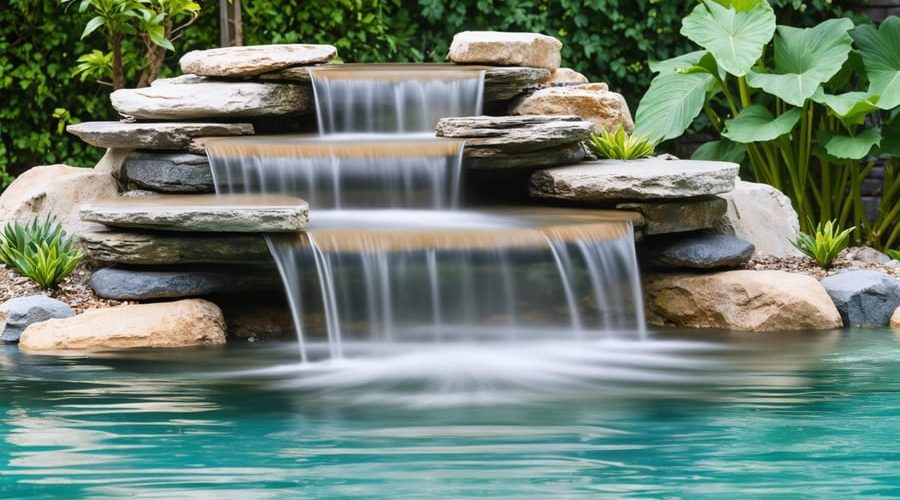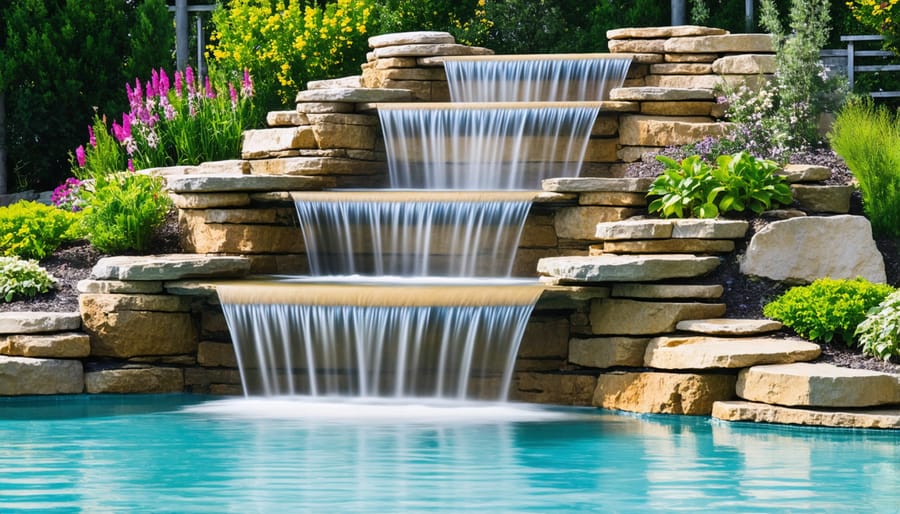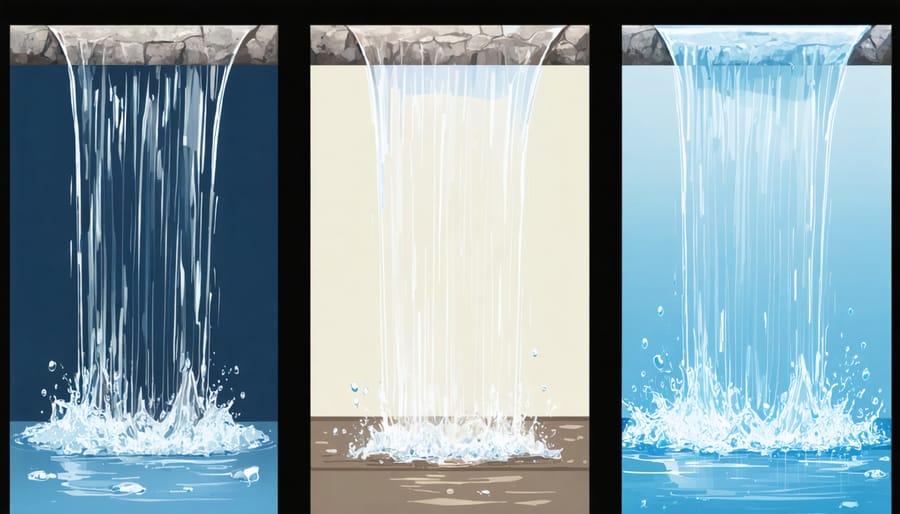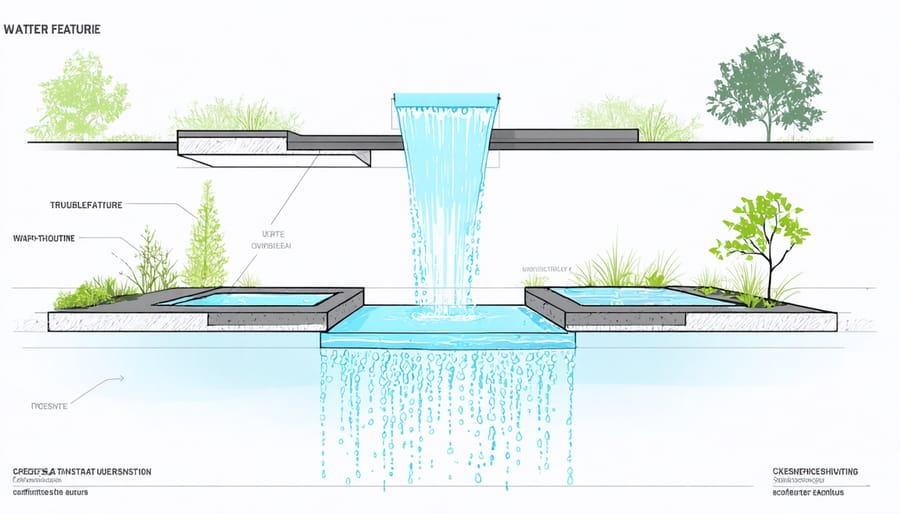
Perfect High Water Sounds: Transform Your Water Feature into a Soothing Oasis
The mesmerizing sound of flowing water transforms any outdoor space into a tranquil sanctuary, whether cascading from a dramatic waterfall or trickling gently through a stream bed. Creating the perfect water sound isn’t just about aesthetics – it’s an art that combines precise engineering with natural design principles. From the soothing whisper of a gentle brook to the powerful rush of a waterfall, the height, volume, and surface texture of your water feature dramatically influence its acoustic signature. Modern water gardeners can precisely control these sounds by adjusting flow rates, designing custom spillways, and incorporating natural elements like rocks and curved surfaces. Understanding these fundamental principles allows you to craft the exact ambiance you desire, whether you’re masking urban noise or creating a meditation-friendly environment. This guide will help you master the techniques needed to achieve the perfect water sound for your outdoor sanctuary.
Understanding High Water Sounds
Types of High Water Sounds
High water sounds come in several distinctive variations, each creating a unique atmosphere in your water feature. The cascade effect produces a powerful, sheet-like flow of water that creates a bold, dramatic sound perfect for drowning out urban noise. Waterfalls offer a more natural, tumbling sound that varies based on their height and volume – taller falls generally produce deeper, more resonant tones.
For those seeking gentler acoustics, the trickling effect creates a subtle, musical quality as water flows over rocks or stepped surfaces. This option works wonderfully in smaller gardens or meditation spaces. Fountain sprays can produce anything from a fine mist sound to a more substantial splashing effect, depending on the height and force of the water jet.
Stream effects mimic the natural flow of water over rocks and pebbles, creating a gentle babbling sound that many find particularly soothing. For a more dramatic impact, multiple-tier effects combine different water movements, producing a layered soundscape that can be adjusted to suit your preferences. The key is matching the water sound to your space and desired ambiance.
The Psychology of Water Sounds
Water sounds have a remarkable ability to influence our mental state and emotional well-being. The gentle trickle of a small fountain can create a sense of tranquility, perfect for meditation spaces or reading nooks. In contrast, the powerful rush of a waterfall can energize an area, making it ideal for entertaining spaces or masking unwanted noise from nearby traffic.
Research has shown that flowing water produces what scientists call “pink noise,” a type of sound that helps reduce stress and anxiety. Different water heights and speeds create unique acoustic experiences – higher falls produce deeper, more dramatic sounds, while lower cascades offer softer, more soothing tones.
When designing your water feature, consider how you want the space to feel. A series of small drops creating a musical splash pattern can spark creativity and playfulness, while a smooth sheet of water flowing over rocks tends to promote relaxation and peace. The sound of rain-like droplets often reminds people of childhood memories, bringing comfort and nostalgia to your outdoor space.
For maximum psychological benefit, try to match the water sound to your intended use of the space. A meditation garden might benefit from gentle ripples, while a poolside entertainment area could handle more dramatic water acoustics.
Creating the Perfect High Water Sound
Water Flow Rate Control
Controlling water flow rate is key to creating the perfect sound in your water feature. Think of it like adjusting the volume on your favorite music – too high, and it becomes overwhelming; too low, and you miss the magic. Modern water flow meters can help you achieve precise control over your water feature’s sound.
Start by testing different flow rates with your pump’s adjustable settings. For a gentle, peaceful sound, reduce the flow to create a trickling effect. This works beautifully for small features or meditation gardens. To achieve that rushing mountain stream sound, increase the flow rate gradually until you hear that energetic splash you’re after.
Remember that the height of your water drop also affects the sound. Try adjusting both the flow rate and drop height together – lower flows with shorter drops create softer sounds, while higher flows with taller drops produce more dramatic effects. Don’t be afraid to experiment until you find that perfect combination that brings music to your garden.
Keep in mind that different features may need different flow rates to sound their best. A waterfall might need more flow than a fountain to achieve the same sound level.

Surface Materials and Textures
The surface material you choose for your water feature plays a crucial role in shaping its sound quality. Natural stone surfaces, like slate or granite, create crisp, clear sounds as water flows over them. These materials tend to produce higher-pitched notes that many find refreshing and energizing. In contrast, smoother surfaces like polished marble or concrete generate softer, more mellow tones.
Textured materials add interesting layers to your water soundtrack. Rough-cut stone creates bubbling sounds as water tumbles across its uneven surface, while innovative water feature materials like copper or stainless steel can produce musical, tinkling effects. Even the pattern of texturing matters – vertical ridges create different sounds than horizontal grooves.
For a more natural sound, consider using river rocks or pebbles. These materials mimic the gentle babbling of streams and create a soothing atmosphere. Wood elements, while less common, can add warm, organic tones to your water feature, though they require proper sealing and maintenance to last.

Height and Distance Factors
The height from which water falls and the distance it travels through the air significantly impact the sound it creates. A drop of just a few inches produces gentle ripples and subtle sounds, perfect for meditation spaces. As the height increases to 1-2 feet, you’ll hear more distinct splashing and melodic tones. For dramatic effects, falls of 3 feet or more create powerful, energetic sounds that can mask unwanted noise.
The projection distance also plays a crucial role. Water that falls straight down produces crisp, focused sounds, while water that projects outward creates a broader, more dispersed sound effect. When water travels further horizontally, it tends to break into smaller droplets, resulting in a lighter, more musical quality. Experimenting with different heights and projection distances allows you to fine-tune your water feature’s sound to match your desired ambiance.

Common Problems and Solutions
Reducing Splash Noise
Reducing splash noise in your water feature is easier than you might think, and there are several effective methods to achieve a more pleasant sound. One of the simplest solutions is adjusting the height of your water fall – lower heights typically create less splashing. Try experimenting with different heights until you find the sweet spot that balances visual appeal with sound level.
Adding rocks or decorative elements beneath the water fall helps break up the water flow more gradually, reducing the impact noise. Position larger rocks first, then arrange smaller stones around them to create a natural-looking cascade effect. Another effective technique is installing deflectors or splash guards, which help direct water flow and minimize unwanted spray.
For fountain features, consider using fountain nozzles designed specifically for reducing splash. These specialized nozzles create more controlled water patterns that minimize impact noise while maintaining visual appeal. You can also add floating elements like lily pads or decorative balls to help absorb some of the splash impact.
Don’t forget about water depth – maintaining proper water levels in your feature is crucial. A deeper catch basin helps reduce splash noise by providing more space for water to disperse upon impact.
Balancing Sound Levels
Finding the perfect balance for your water feature’s sound level is like fine-tuning a musical instrument. Start by adjusting the pump’s flow rate – a higher flow creates louder sounds, while a lower flow produces gentler effects. Position rocks and water deflectors strategically to modify the sound; larger rocks create deeper tones, while smaller ones produce lighter splashing sounds.
For a more subtle ambiance, try spreading out the water flow across multiple streams rather than one concentrated fall. The height of your water drop also matters significantly – higher drops generally create louder sounds, so consider lowering the water fall height if the sound is too intense.
Test your adjustments during different times of the day, as ambient noise levels change. What sounds perfect during a busy afternoon might be too loud in the evening. Remember that surrounding plants can help absorb and soften water sounds, making them excellent natural sound buffers.
If you’re still struggling with volume, consider installing a variable speed pump that allows you to adjust water flow throughout the day. This gives you complete control over your water feature’s acoustic presence in your garden.
Creating the perfect water sound for your garden or landscape is both an art and a science, but it’s one that anyone can master with patience and creativity. We’ve explored how different flow rates, surface textures, and design elements contribute to creating everything from gentle ripples to dramatic cascades. Remember that the ideal sound level should complement your space without overwhelming it, serving as a soothing backdrop rather than a distraction.
Don’t be afraid to experiment with different configurations and materials. Start small by adjusting your pump’s flow rate or adding stones to modify the water’s path. Listen to how the sound changes throughout the day and in different weather conditions. Pay attention to how your water feature interacts with the surrounding environment and make adjustments accordingly.
The beauty of water features lies in their versatility and personal nature. What sounds perfect in one garden might not suit another, so trust your instincts and preferences. With the knowledge and techniques we’ve shared, you’re well-equipped to create your ideal water soundtrack. Whether you’re aiming for a meditative trickle or a dynamic waterfall, the perfect sound is within your reach.
